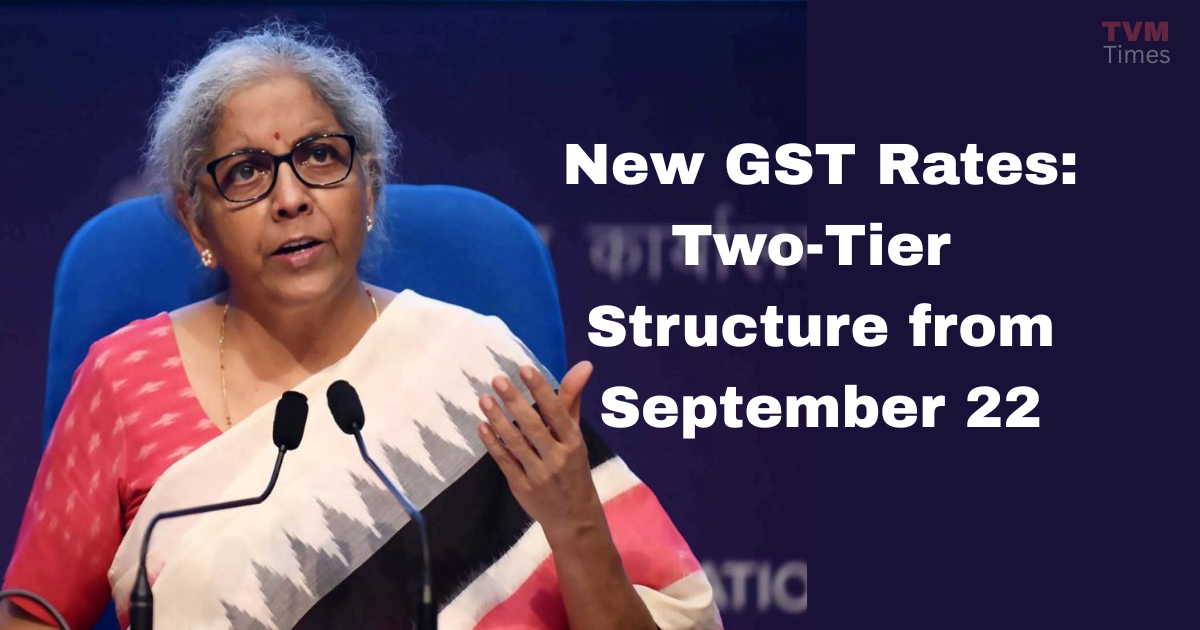
New GST two-tier structure 2025 Effective from September 22, GST will be a two-tier structure, wherein majority of goods and services will attract tax of 5 and 18%
The Finance Ministry has notified a major reform in India’s indirect tax system by revising the Goods and Services Tax (GST) structure. Effective September 22, 2025, the GST regime will transition from the existing four-rate system to a simplified two-tier structure.
Under the revised framework of new Structure
- The majority of goods and services will be taxed at either 5% or 18%.
- Ultra-luxury items will attract a higher tax rate of 40%.
- Tobacco and related products will remain under the existing 28% slab plus applicable cess, keeping them in the “demerit goods” category.
This change marks a significant departure from the current system, where GST is levied in four slabs—5%, 12%, 18%, and 28%— in addition to the compensation cess charged on certain categories such as luxury cars, tobacco, and aerated drinks.
Why the Change Was Needed
Since its introduction in July 2017, the Goods and Services Tax has undergone several tweaks and adjustments to balance revenue collection with consumer affordability. However, over the years, both businesses and economists have raised concerns about the complexity of multiple slabs, leading to confusion and litigation.
By consolidating the tax system into just two standard slabs (5% and 18%), the government aims to:
- Simplify compliance for businesses, especially MSMEs and startups.
- Reduce classification disputes, where goods or services were often contested between two nearby tax slabs (e.g., 12% vs. 18%).
- Improve transparency for consumers, making it easier to understand what tax rate applies to a product or service.
- Enhance revenue predictability by reducing slab overlaps.
Impact on Consumers
For the average consumer, the new two-tier system means greater clarity on pricing. Essential goods and services will continue to remain in the lower 5% slab, ensuring affordability. Items of mass consumption such as basic food products, education, and healthcare are unlikely to see any major tax burden.
Products and services that were previously taxed at 12% are likely to move either to 5% or 18%, depending on their classification. This may result in price adjustments—with some goods becoming slightly cheaper, while others may cost more.
Luxury goods, which earlier attracted 28% GST plus cess, will now largely move to the 40% tax bracket if they fall under the ultra-luxury category. For consumers of premium products, this could mean higher prices.
Impact on Businesses
For businesses, particularly those operating in retail, manufacturing, and services, the shift will bring both opportunities and challenges.
- Ease of Compliance: This is expected to particularly benefit small and medium enterprises that often face resource constraints in managing tax compliance.
- Pricing Adjustments: Companies may need to rework their pricing strategies, especially for goods that were earlier in the 12% category.
- Input Tax Credit (ITC): The two-tier structure could also improve the efficiency of input tax credits, reducing the mismatch issues faced by businesses under the four-slab system.
Sector-Wise Implications
- FMCG (Fast-Moving Consumer Goods): Many items currently in the 12% bracket may shift to 5%, making everyday goods cheaper. However, products categorized as “non-essential” may fall under the 18% slab.
- Automobiles: Entry-level cars may remain affordable under the 18% slab, but luxury and premium vehicles could see a spike in prices due to the new 40% ultra-luxury tax rate.
- Real Estate & Construction: Services related to affordable housing are expected to stay in the lower slab, but premium housing and commercial real estate may face higher taxation.
- Hospitality & Tourism: Budget hotels and travel services may get relief with a 5% rate, while high-end hospitality services are likely to continue under the higher 18% category.
- Tobacco & Sin Goods: No relief has been extended here. The government has retained the 28% slab plus cess, signalling its continued stance on discouraging consumption of harmful products.
Government’s Perspective
According to Finance Ministry officials, the decision to restructure GST was taken after extensive consultation with the GST Council, which includes representatives from both the Centre and the States. The move is expected to increase efficiency in tax collection and reduce compliance costs for businesses and New GST two-tier structure 2025 applicable from 22nd sep. 2025
Conclusion
The Finance Ministry’s notification marks a historic shift in India’s GST framework. By replacing the four-slab system with a two-tier structure, the government has taken a decisive step toward simplifying the indirect tax regime.














